How to Draw a Cheetahs Face Easy
Cheetahs are one of the most remarkable animals on the planet. They are some of the fastest and most agile creatures that roam the earth, and although we cannot create a tutorial that goes nearly as quickly as they can, we can show you how to create a realistic cheetah illustration in only 17 short steps. Beginning with the basic shapes and elements, we then move on to creating realistic texture and coloring. Collect your drawing supplies, find a comfortable seat, and let us get down to our cheetah drawing.
Table of Contents
- 1 A Fast Step-by-Step Cheetah Drawing Tutorial
- 1.1 Step 1: Outlining the Shape of the Main Body
- 1.2 Step 2: Creating the Cheetah's Head
- 1.3 Step 3: Shaping the Hindquarters
- 1.4 Step 4: Drawing the Ears of Your Cheetah Illustration
- 1.5 Step 5: Joining the Head and Body with the Neckline
- 1.6 Step 6: Shaping the Front Legs of Your Cheetah Illustration
- 1.7 Step 7: Drawing the Cheetah's Back Legs
- 1.8 Step 8: Outlining the Tail of Your Cheetah Sketch
- 1.9 Step 9: Creating the Final Outline of Your Cheetah Drawing
- 1.10 Step 10: Creating Facial Details on Your Cheetah Sketch
- 1.11 Step 11: Painting the First Color Coat
- 1.12 Step 12: Adding a Second Lighter Color Coat
- 1.13 Step 13: Creating the Separate Fur Coat
- 1.14 Step 14: Adding Highlights to Your Cheetah Sketch
- 1.15 Step 15: Adding Color to Facial Details
- 1.16 Step 16: Adding the Spots to the Cheetah Illustration
- 1.17 Step 17: Adding the Finishing Touches to Your Cheetah Drawing
- 2 Frequently Asked Questions
- 2.1 Can You Create a Cheetah Illustration from Scratch?
- 2.2 Is Cheetah Drawing Difficult?
A Fast Step-by-Step Cheetah Drawing Tutorial
The hardest part of any drawing, particularly animal drawings, is knowing where to start. With a range of different limbs and head shapes, the best way that we have found to begin tackling an animal drawing is to use simple shapes and lines to map out the structure.
You can see a brief outline of the steps of our cheetah drawing tutorial in the image below, featuring the beginning construction steps.
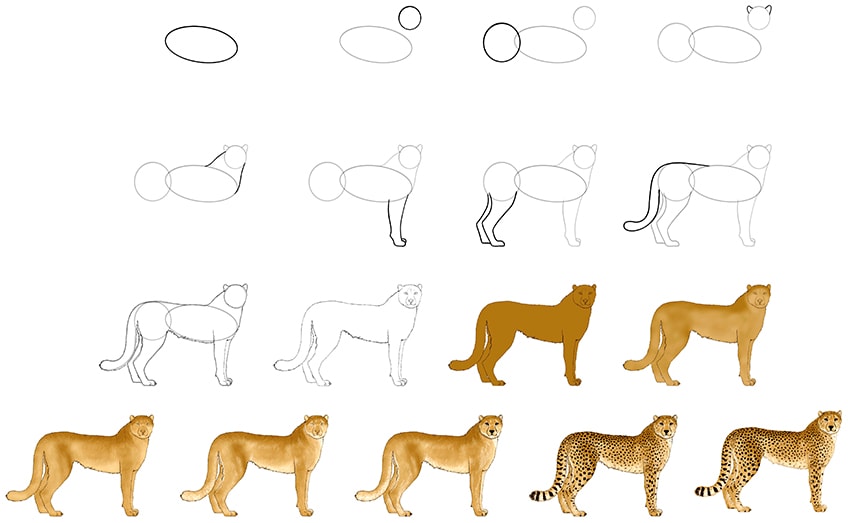
In our examples, we use paint as our coloring medium, but the choices are endless. Whether you are a graphic artist, or you prefer to use more physical mediums like coloring pencils or paint, you can easily adapt the coloring steps to suit your needs.
Now that we are all set up and ready to go, gather your supplies, and let us begin creating a beautiful and realistic cheetah sketch.
Step 1: Outlining the Shape of the Main Body
When we begin constructing the shape of an animal, we always start with the largest part of the body to help us nail the proportions. As such, for our cheetah illustration, we are going to begin by using a long oval shape to represent the main body shape of the big cat. This main oval shape should be slightly tilted, with the right side sitting a little higher than the left.
If you hope to complete craft
projects where you need paint that will work well for any number of surfaces, then craft paint is your
go-to! The consistency is smooth, creamy, and easy to use.
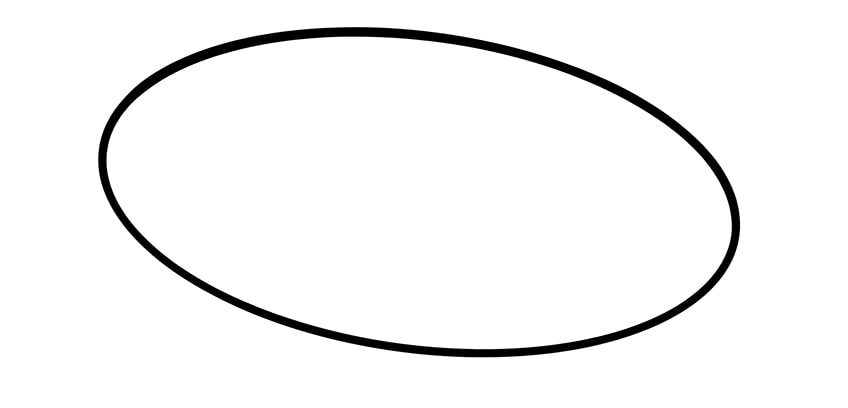
Step 2: Creating the Cheetah's Head
To represent the head of your cheetah sketch, you are going to use a small circle. This circle should be placed on the right side of the main body oval.
You want it to sit just above the right end of the main body, with a little space between them for the neck.
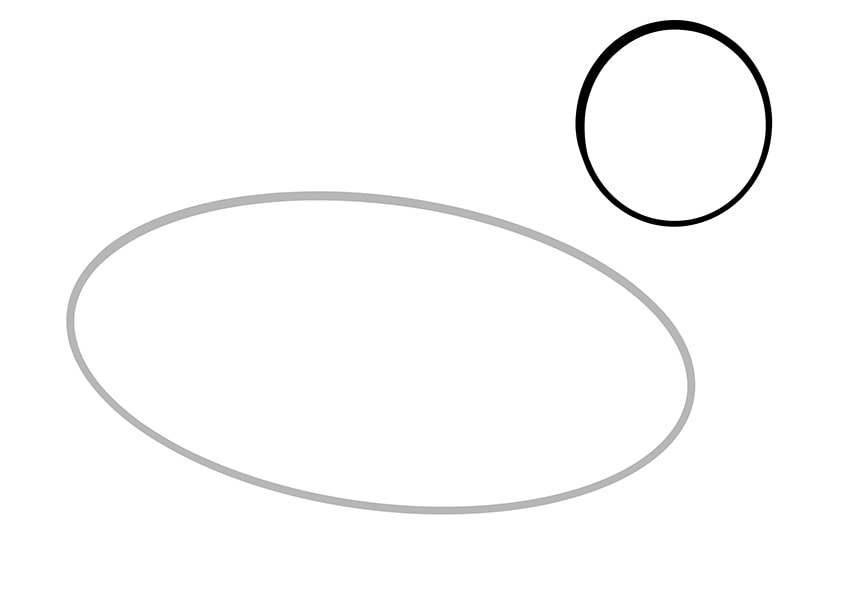
Step 3: Shaping the Hindquarters
The strong hindquarters of the cheetah help to increase its speed and agility. To outline this shape, you can use a large slightly long circle. Draw this circle on the left side of the main body oval, overlapping the point slightly.
At this stage, this circle may seem a little bit big, but once we have all of the other elements laid down, it will fit in perfect harmony.
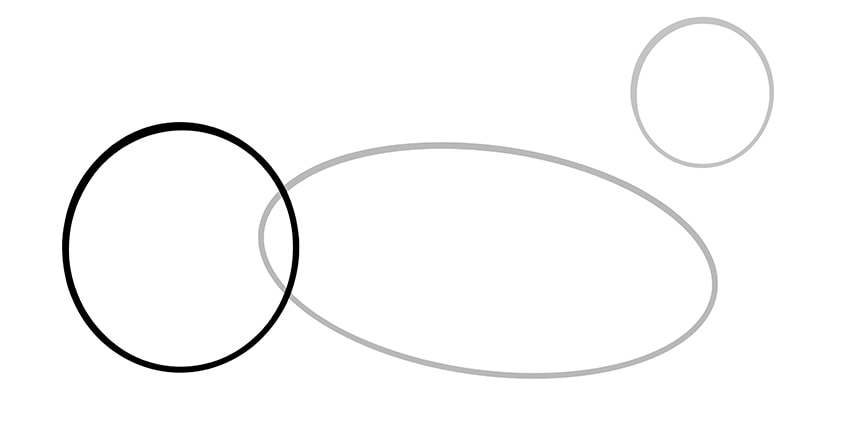
Step 4: Drawing the Ears of Your Cheetah Illustration
This step is quick and easy. On either side of the head circle, create two slightly curved arches towards the top. These ear shapes should be in the same position on either side of the head.
For the sake of correct perspective, the one on the right should be ever so slightly bigger than the left.
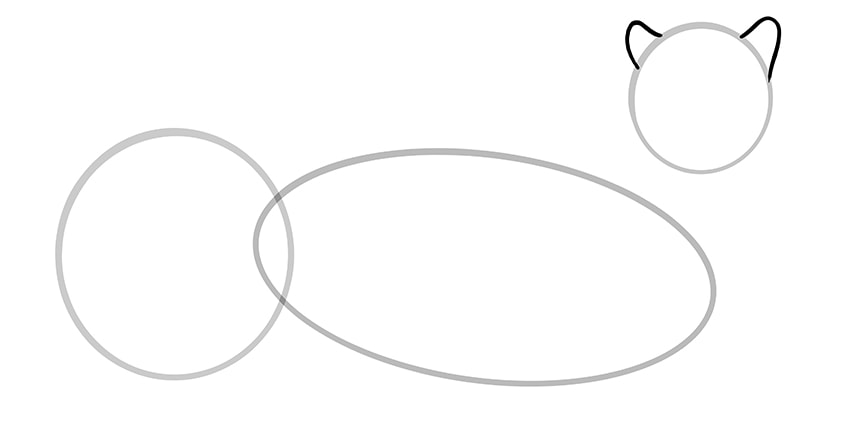
Step 5: Joining the Head and Body with the Neckline
You are now going to draw in the neck of your cheetah sketch, and use it to connect the head to the main body construction shapes. Begin with the upper neckline, creating a slightly curved line between the bottom of the left ear and the top of the main body oval. For the second neckline, curve a line up from the right point of the main body shape up to join the bottom side of the head circle.
This neck may seem a little chunky, but it only appears this way because of the perspective of our drawing with the cheetah's head facing us.

Step 6: Shaping the Front Legs of Your Cheetah Illustration
This step is another where perspective comes into play significantly. Although the cheetah has two front legs, the one is almost completely hidden behind the other, so we are technically only drawing one front leg. Begin this front leg shape with the front line extending down and slightly back from the point where the neckline meets the main body. At the bottom of this line, draw a small curved paw shape, taking the line up to form a heel and then curving it up to join the bottom of the main body oval again.
To finish this step, draw a partially visible paw curve just above the one you just drew, to hint at the existence of two legs.
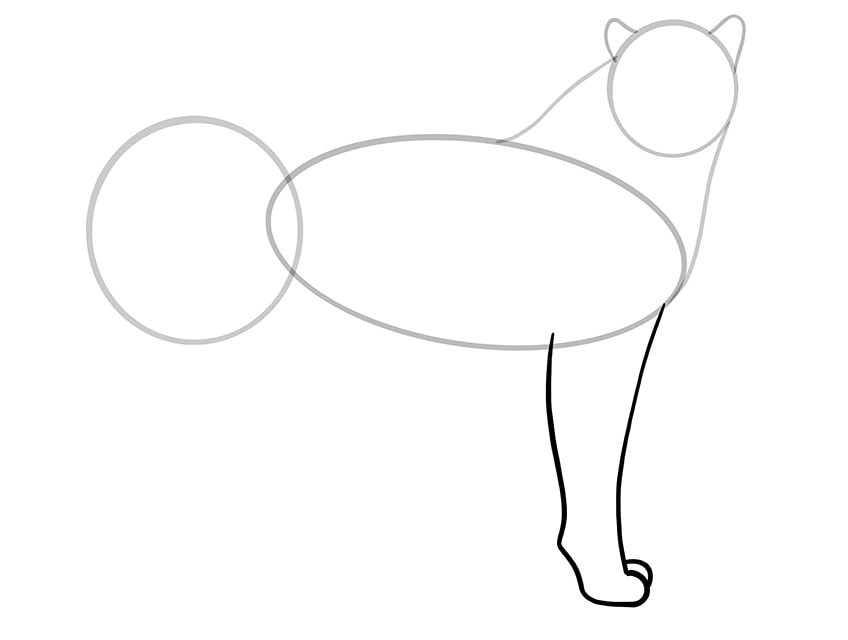
Step 7: Drawing the Cheetah's Back Legs
While only one of the front legs is visible in our perspective, more of the second back leg can be seen. Begin by drawing the leg that is closest to us and can be seen fully. Curve the front line down from the right bottom side of the rear body circle, shape the heel and paw, and then take the line back up, curving forwards to meet the bottom of the rear body oval.
For the second back leg, simply create the back shape just behind the first one.
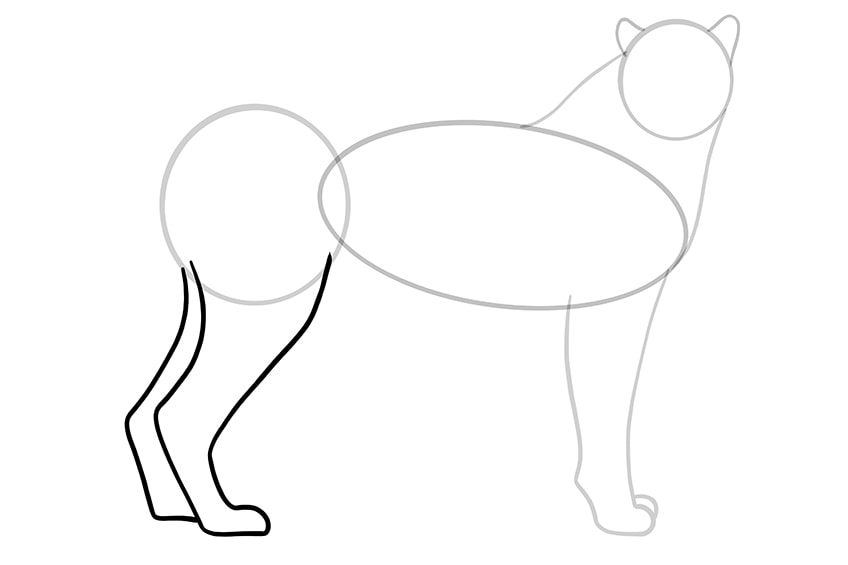
Step 8: Outlining the Tail of Your Cheetah Sketch
Not only are we shaping the tail in this step, but we are also creating the final curve of the back body. Begin by taking a line from the top of the main body oval, and curving it up and around the rear body circle. Then, take this line slightly out beyond the rear body circle, and curve it down and back to create a thick, snake-like tail.
Finish the tail step by curving the line back up to meet the rear body circle just behind the back leg.

Step 9: Creating the Final Outline of Your Cheetah Drawing
After all of this hard work with the construction lines and shapes, it is finally time to put them to use and see the value that they bring to a drawing. Following the construction lines quite closely, you are going to draw the final outline of your cheetah sketch. Begin with the head, using a rough outline of short strokes to create a fur-like appearance.
Follow the construction lines down the necklines onto the body.
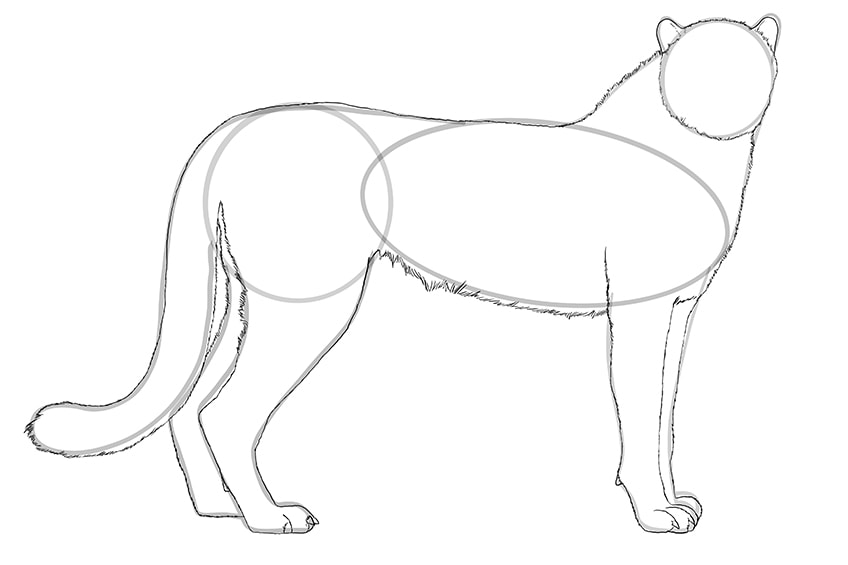
You can stick closely to the construction lines for the rest of the body, except when it comes to the front legs. Create a separation within the front leg, creating two separate legs. For the paws of all four legs, create small curved toe separations, finishing each with a small curved claw. When it comes to outlining the parts of the cheetah that are lower to the ground, like the belly and the back of the legs, you can make the fur strokes slightly longer.
When you are happy with your outline, you can erase any remaining construction lines, and move on to the next step.
Step 10: Creating Facial Details on Your Cheetah Sketch
In this step, we are going to concentrate on adding some realistic facial features to our cheetah illustration. Begin by finding the center point of the face, and create a slightly round upside-down triangle to represent the nose. From here, take a line down and separate it into a curving mouth line on either side. Around this nose shape, create a structural shape with short furry lines. These lines should lead up to the eyes in the upper third of the face. Crete two almond eye shapes with an iris and pupil in each.
Finish this step by creating a few squiggles on the forehead and around these facial features for some additional furry texture.
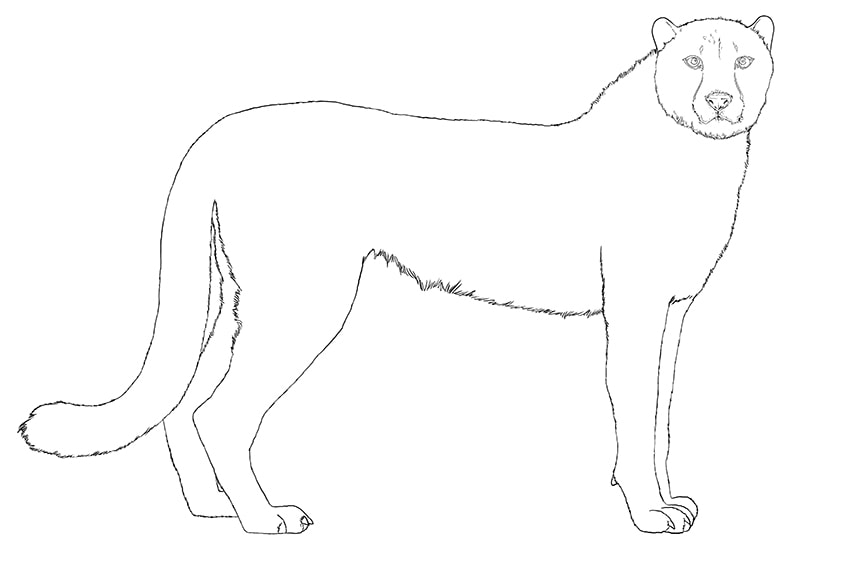
Step 11: Painting the First Color Coat
In the next few steps, we are going to gradually build up a realistic colored and textured coat for our cheetah sketch. In this first coloring step, use a regular brush and a caramel brown shade to fill the entire body and head of your cheetah drawing with an even base coat of color.
Whichever medium you are using for the coloring steps, make sure that this base coat is even and does not have any splodges of color.
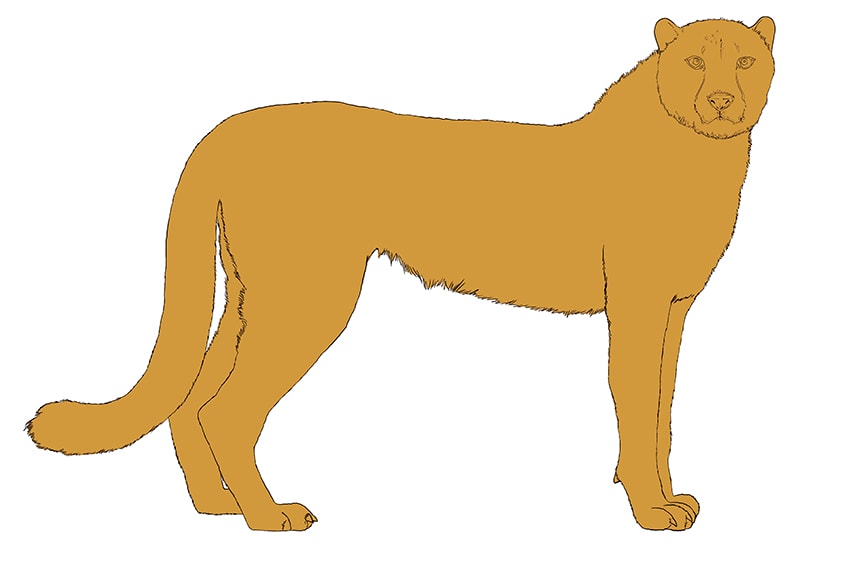
Step 12: Adding a Second Lighter Color Coat
Our base color is quite dark, and you will see in the final product that it is actually much lighter in many places. In this step, you are going to lighten most of the body of your cheetah illustration with a touch of white paint. In the next step, you are going to create a separate fur coat, and this lighter base helps you achieve a more realistic blend. Use a soft blending brush and a little white paint to gently dab the areas around the face, chest, belly, and legs.
The only part that you want to be purely the first base color is the top of the head and back.
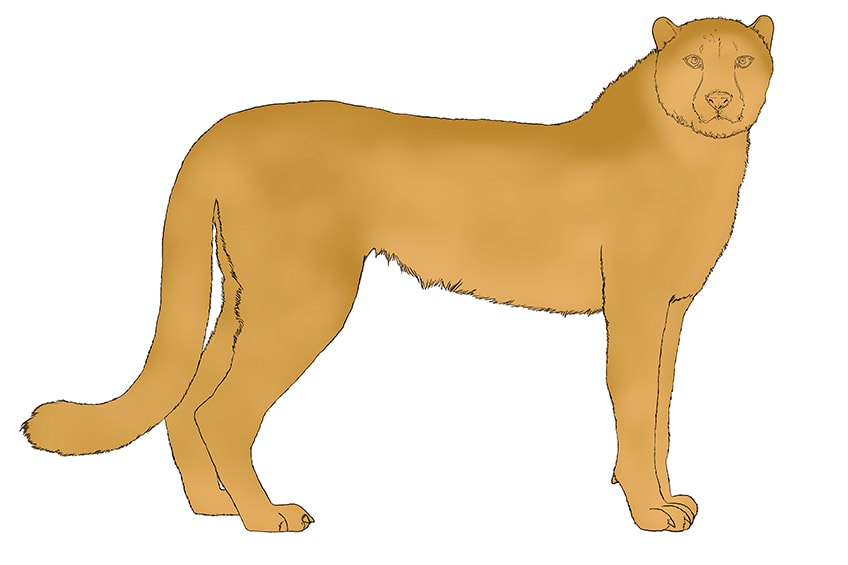
Step 13: Creating the Separate Fur Coat
In this step, you are going to build on the process in the last step. Using a soft brush and white paint, lighten the main areas of the body even further. You can then use a fine sharp brush with some white paint to create fur strokes around the body, following the curvature of the different elements.
Finish the step by using a clean and dry blending brush to gently smooth the second color coat.
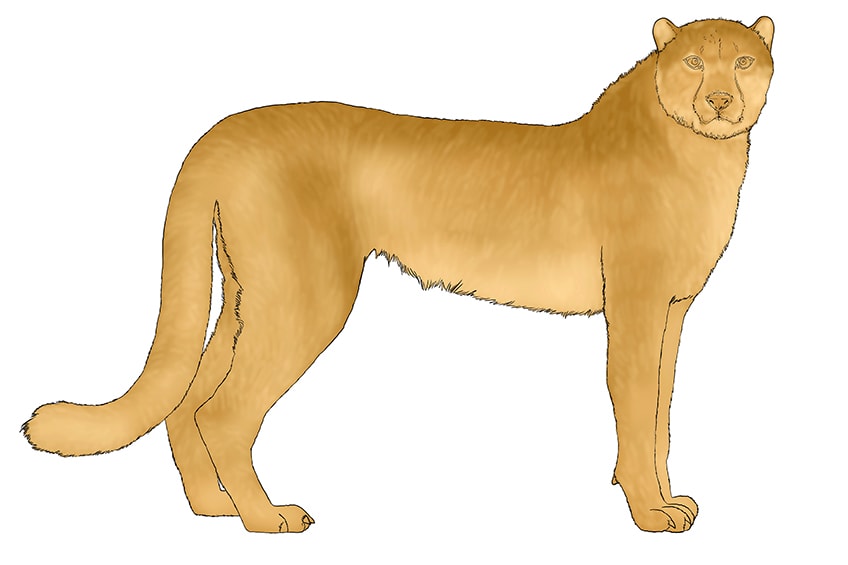
Step 14: Adding Highlights to Your Cheetah Sketch
Find your small sharp brush again, and use white paint to add a highlighted layer of fur lines throughout the lighter areas. Follow the curve of the cheetah's outline, creating more intensity in the highlights. This process not only creates highlights but also texture in your cheetah drawing. Focus this highlight along the bottom of the face, around the facial features, within the ears, Along the bottom sides of the belly, chest, tail, and the back lines of the legs.
You do not want to fill these areas entirely, instead, let some of the previous coats show through to create a layered texture.
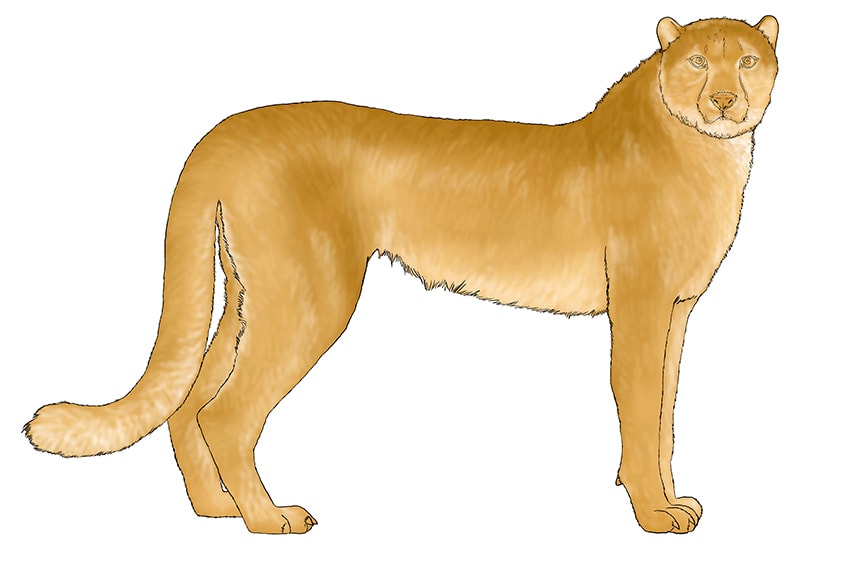
Step 15: Adding Color to Facial Details
Now that we have the base layer of the fur coat, it is time to add some color detail to the face of your cheetah drawing. Begin by using a sharp small brush and some dark brown paint to fill in the eyes. Next, use the same brush and a touch of black paint to outline the rest of the facial features, including the nose lines, the nose, and the mouth. Clean this small fine brush, and then use a touch of light gray paint to add hairline strokes around the face and within the ears. You can then use a touch of dark gray paint to fill in the claws on each of the paws.
Finish this detailing step by using a soft blending brush and some white paint to add light, rough-textured patches throughout the main body.
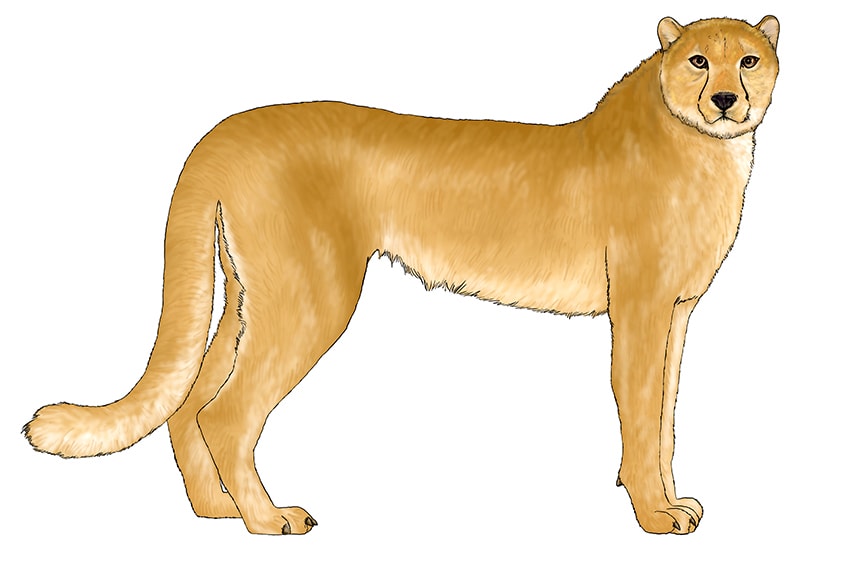
Step 16: Adding the Spots to the Cheetah Illustration
It has finally come time to add the most characteristic element of the cheetah to your drawing; the spots! These beautiful dark brown spots are used by cheetahs for camouflage and safety. Begin by using a fine brush and dark brown or black paint to create a range of differently sized and shaped dots and patterns throughout the cheetah's body.
Around the head and neck, these spots and patterns should be much smaller, and they can increase in size as you move towards the rear, with the largest ones being at the end of the tail.
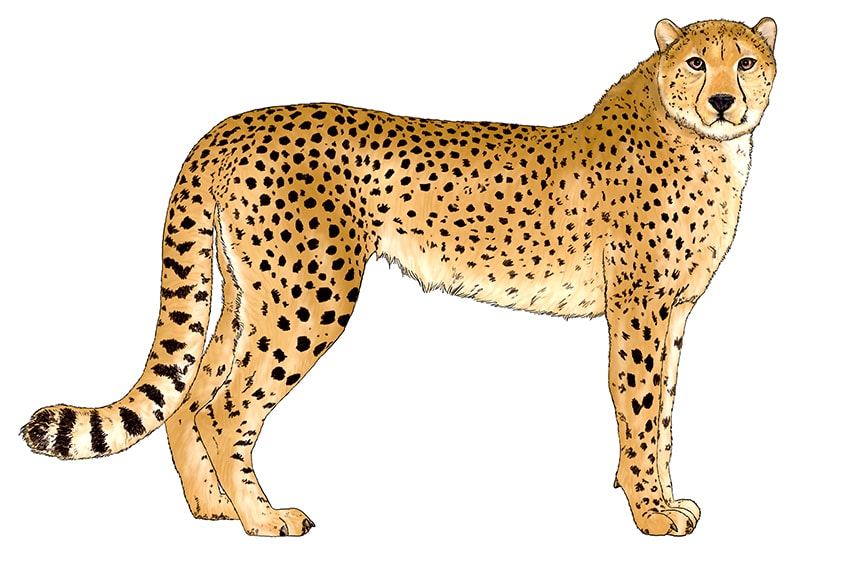
Step 17: Adding the Finishing Touches to Your Cheetah Drawing
In this final step, you are going to remove the outline, trace textural lines, and add a glint to your cheetah's eye. Begin by erasing the outline by tracing over it with the corresponding color at each point. You can then move onto the textural lines within the body, once again using the corresponding color to trace over the existing ones.
Finally, use a very sharp brush and a touch of white paint to add a glint to each eye.
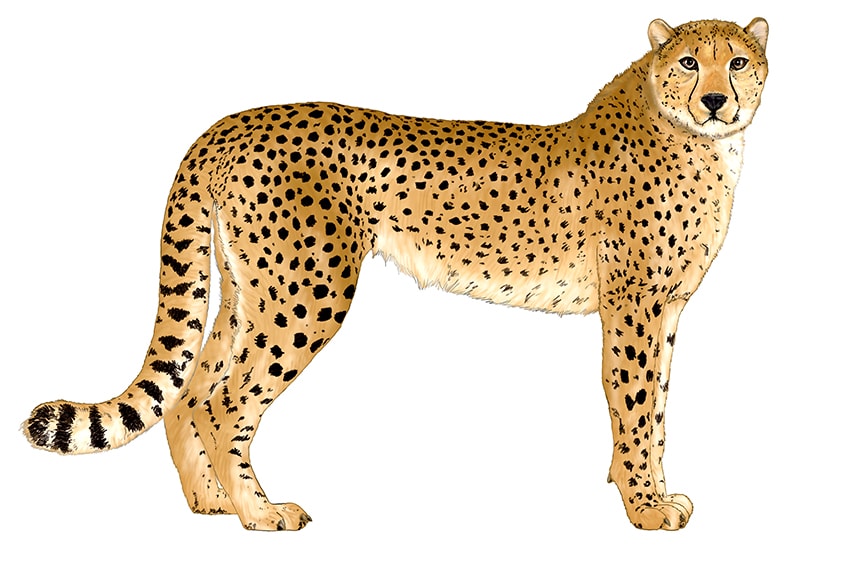
Well done for finishing our easy cheetah drawing tutorial! Hopefully this quick and simple tutorial has left you with a beautifully realistic cheetah illustration, and has given you confidence to pursue other, more complicated animal drawings. Be sure to come back and join us for more animal drawing tutorials.
Frequently Asked Questions
Can You Create a Cheetah Illustration from Scratch?
Absolutely. It is very easy to create a realistic cheetah drawing from scratch. Often having a reference photo can make the process a lot easier, but with our easy-to-follow cheetah drawing tutorial, you can simply follow our simple and comprehensive steps.
Is Cheetah Drawing Difficult?
Objectively, drawing any animal can pose a challenge for any artist. From proportions to realistic texture, there are a few hurdles that you need to overcome. Fortunately, we make the cheetah drawing process easy with our comprehensive tutorial that guides you through each important step with detailed examples.
Source: https://artincontext.org/how-to-draw-a-cheetah/
0 Response to "How to Draw a Cheetahs Face Easy"
Post a Comment